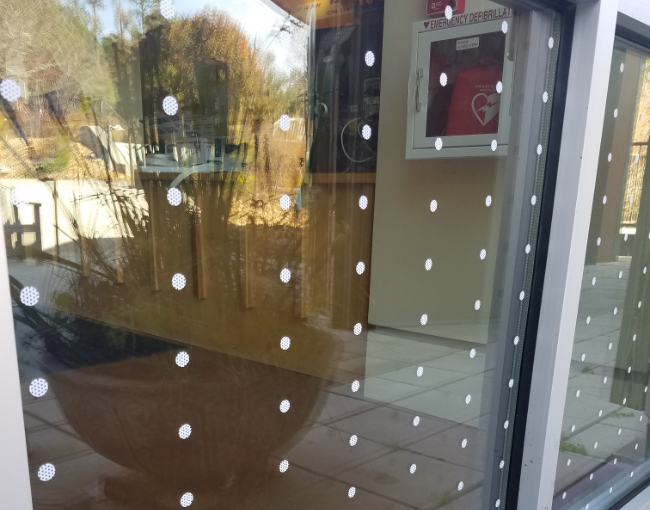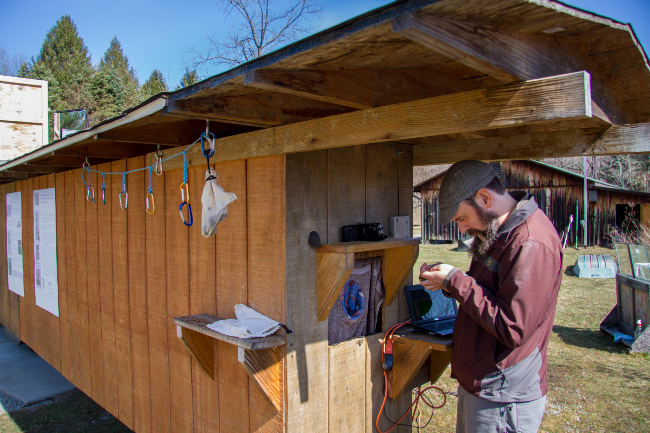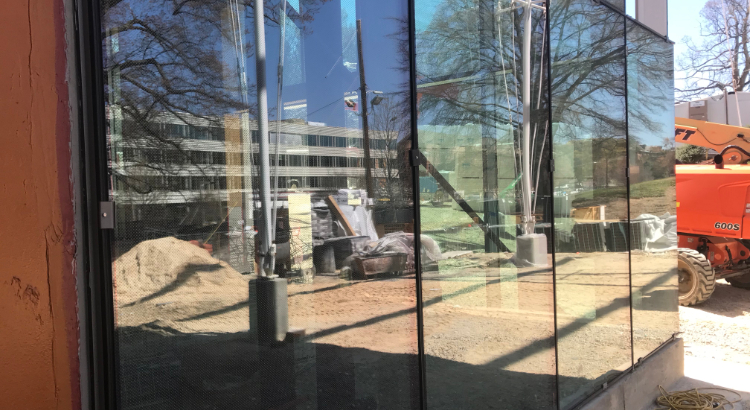Smack! We looked outside and saw him on the porch. A male house finch, or maybe a purple finch. Lying on his side. Eye wide open.
I slid open the glass door with which he’d just collided. He didn’t give me a chance to play emergency medic, though.
The little songbird shook off the daze, righted himself and zipped straight out into the world — as directly as possible away from his bad experience with a strange invisible object. Even then, he wasn’t out the woods.
Our afternoon visitor may have sustained enough of a head injury to become part of a stunning body count. According to the most extensive analysis of the topic, 365 million to 988 million birds die in the United States annually after flying into windows. Aside from habitat loss and cats, building collisions are the top human-related killers of avian creatures.
Contrary to popular imagination, skyscrapers cause only a fraction of those deaths. Millions of buildings below 10 stories have turned the urban and suburban landscape into a vast maze — right at most birds’ flight levels and spotted with reflective booby traps.
“Birds didn’t evolve to handle windows,” says the American Bird Conservancy’s Christine Sheppard, perhaps the nation’s leading advocate on bird collision deaths. “There is no transparent barrier in nature. This is something that humans have invented.”
The Kendeda Building for Innovative Sustainable Design would fall right in the sweet spot (if that’s the right term for it) of those booby traps, if it weren’t for a commitment to bird-safe glass that bird advocates hope will be much more common in buildings. It features 9,500 square feet of window glazing from ground level to about 30 feet above grade. Surrounded by trees and an edible landscape of berries and flowers, all that glass threatens to reflect an inviting landscape for tanagers, buntings, hummingbirds and other species. But about a third of those windows include a simple dot-matrix pattern that could save hundreds of birds over the life of this one single building.
Surprisingly — especially considering the outsize role that birds play in nature — bird-friendly design hasn’t gotten much attention from green-building certification programs. LEED offers an optional one-point Pilot Credit for bird-safe windows and other “collision deterrence” measures. The U.S. Green Building Council doesn’t collect data on how many projects take advantage of that credit, but it’s likely to be a small number.
The more rigorous Living Building Challenge doesn’t mention bird-friendly design or bird-safe windows. Part of the problem is that LBC doesn’t lend itself as easily as LEED to prescriptive solutions, because it’s based on broad mandates rather than a checklist of options.
But ornithologists and advocacy groups, backed by the nation’s multitudes of birders, are bringing attention to the issue. Adam Betuel came to Atlanta three-and-a-half years ago as conservation director of the local Audubon Society. Among his first projects: Mobilize volunteers to get a better idea of how many and what species of birds were being killed by area buildings.
The findings of his volunteer-driven survey have been sobering. Patrolling a tiny fraction of all the buildings in the region and with little access to private spaces, Project Safe Flight Atlanta has so far tallied more than 1,300 deaths spread among more than 100 species.
“By far, it’s one species more than any other: the ruby-throated hummingbird,” Betuel notes. “After that, comes the Tennessee warbler, which stops in Atlanta during its fall migration.”
Those two hardest-hit species are followed by the American robin and the cedar waxwing. Migratory songbirds dominate the top of the list, and research shows that’s probably the case across the country. There are two likely reasons: Temporary residents don’t have time to get to know the local landscape. And, while here, migratory birds are very actively foraging food to fuel their journeys.
Bird-safe buildings: a rare species
With the issue’s profile rising, Betuel’s Audubon chapter has received $75,000 in grants from the Disney Conservation Fund to treat six metro Atlanta buildings with bird-friendly window film. Retrofits usually aren’t as effective as pre-construction bird-friendly design or permanent bird-safe glass.
Betuel knows of only one building in the state — Zoo Atlanta’s new reptile house — designed and built with bird-safe glass. But, in 2016, the Kendeda Fund and Georgia Tech announced their commitment to construct a Living Building.
“I remember thinking that it would be sad for [the Kendeda Building] to be built and to have all these eco-friendly features but also to be contributing to bird deaths,” Betuel says. “Eco-friendly buildings can be worse for birds, because they typically have a lot of windows and they also tend to have trees and plants around them.”

It was Betuel who tracked down Kendeda Building design team leader Joshua Gassman to lobby for bird-friendly features. His spiel quickly got the Lord Aeck Sargent architect’s attention.
“It’s a shockingly huge issue,” Gassman recalls thinking. “He was coming to us fairly late in the design process. But let’s just say this fell on receptive ears. I could tell right away that this is something we should be concerned about.”
Cost was a concern. That’s often the case for green features that are proposed after a building’s general design has been set. Unbeknownst to Gassman, however, Beutel and his colleagues were working another angle. Diana Blank, the philanthropist who founded the Kendeda Fund, happens to be an avid birder. When she learned of the problem from a friend who was a past Atlanta Audubon board chair, Blank offered to add money for bird-friendly glass to the project’s budget. (The added expense turned out to be $32,000 — less than a fifth of a percent of total construction cost.)
“I’ve been a bird watcher with a life list for years, and honestly I did not think over all that time, ‘Oh, I wish we had glass to prevent bird collisions,’” Blank explains. “But when it was pointed out to me, I jumped on board. If you’re going to build a building that shows people all the good things you can do, this really should be among them.”
That set the team off on the kind of research that seems to characterize Living Building projects. The design team tasked Miller Hull Partnership architect Matt Kikosicki, who had experience with bird-friendly projects, to research the options. (LAS and Miller Hull are design partners on the project.) Kikosicki touched bases with Betuel, who in turn suggested that the team consult with Sheppard.
“We can try to get familiar with the specific issues that come up on our projects,” Kikosicki says. “But it’s really helpful to get together with experts and sort of synthesize their information.”
The guru of bird collisions
Sheppard certainly fits the definition of an expert. For more than a decade, she’s made reducing bird collision death her professional mission. Her experience as an ornithologist with a doctorate from Cornell and the former director of bird programs at Bronx Zoo give Sheppard credibility on the science. Her efforts at the American Bird Conservancy have elevated that organization’s Bird Collisions Campaign into a national clearinghouse for research, advice and activism.
“I love birds and I like to solve problems, which is what makes this a perfect job for me,” Sheppard says.
In 2009, Sheppard worked with the Powdermill Nature Reserve in Pennsylvania to construct a bird collision tunnel that would systematically test the way various species responded to different bird-friendly glass designs. That tunnel, together with a second one recently installed at the Bronx Zoo in New York, have now tested products from 20 glass fabricators, according to Sheppard. They’ve found that as many as 94 percent of birds would fly toward a conventional window when given the choice between the conventional window, and one with ceramic patterns, or frits, on the outer pane of the window. (Lest you worry: The tunnels are fitted with transparent nets to protect the test subjects from smacking into the glass.)

Sheppard and her team also found that the patterns should follow a “two-by-four rule.” To signal to birds that they should avoid the windows, the unobstructed view must be less than two inches high or less than four inches wide because that happens to be the width and height that most migratory songbirds view as a safe passage.
Sheppard advocates approaches that go beyond bird-safe glass. A 60-page Bird-Friendly Design guide published by the Conservancy suggests that architects mask windows with netting, grilles, shutters and screens where possible. The LEED Pilot Credit, which she helped author, restricts exterior lighting (lights often draw birds toward buildings), and includes a complex formula to lower the “threat level” by discouraging uninterrupted walls of plain, unobstructed glass, especially on lower floors where trees are more likely to be reflected.
Now, a major focus for Sheppard and for allies at the Audubon Society is codes and legislation. In 2011, over the objection of some developers, San Francisco became the first city to adopt Bird Safe Building Standards.
“San Francisco hasn’t died [as a result of the new ordinance],” Sheppard quips. “They haven’t exactly had a slowdown in building.”
Ordinances or building standards are now in place in Cook County, Ill., San Jose, Calif., and the state of Minnesota, among other places. Federal legislation has been introduced by Sen. Cory Booker, D-N.J., and Rep. Mike Quigley, D-Ill.
Much of the legislation is modeled on the LEED Pilot Credit. For all practical purposes, the credit has become the most widely used standard for bird-safe design n jurisdictions without bird-friendly legislation. One example: the Kendeda Building.
“We did use the LEED pilot credit as a guideline,” Gassman says. “It is one of the few resources out there that suggests strategies for avoiding bird collisions.”
Bird safety not as difficult as expected
As it turns out, windows on the east face of the Kendeda Building had been designed to include exterior shades before bird-friendly features were even considered. After consulting with Beutel and Sheppard, however, the design team decided that curtain walls that will offer views of the Georgia Tech Eco-Commons to the west and of the building’s green roof toward the north provided ideal surfaces for bird protection.
Ultimately, Kikosicki stresses, the architects had to balance their bird-safe glass selection against other values. For one, there’s the LBC ban on toxic Red List materials. The manufacturers of one product — a pane containing ultraviolet patterns visible to birds but not humans — “were not super-willing to disclose the ingredients.” The lack of transparency struck that option off the list.
For another, LBC’s Energy Petal requires extreme energy efficiency. For all practical purposes, that means three panes. So a bird-safe solution designed to be installed with an extra pane would have forced the Kendeda Building to require quadruple-glazed windows. That would have required custom fittings and much steeper costs.

Based on Sheppard’s recommendations, the team leaned anyway toward visible patterns, applied as frits, on the outer pane. They opted to purchase the window from Viracon, the nation’s largest architectural glass supplier.
Viracon also happened to be the first glass fabricator to be tested in Sheppard’s tunnel. According to Alissa Schmidt, technical resources manager for the Minnesota-based company, Viracon’s strategy has been “to offer a bird friendly product that was readily available and affordable.”
So the company has focused on solving the bird-collision problem by silkscreening frit patterns onto the outer surface of the glazing that already are part of its product line. Because it’s difficult to separate out the silkscreening specified for bird safety from those purchased for other reasons, Viracon has a hard time quantifying its bird-friendly sales. But, Schmidt says, “we’ve seen the architectural community’s requests for bird-friendly products increase steadily in the nearly 10 years since we first had the American Bird Conservancy test our products.”
Sheppard’s tunnel tests found that dark gray horizontal bands were most effective at dissuaded birds. But the Kendeda Team opted for a gray dot pattern because — while slightly less effective in deterring birds from hitting the windows — it was more fitting aesthetically.
For Betuel, it’s a huge victory.
“There’s a glaring gap on this [buildings with bird-friendly design],” he says. “I don’t know why it is. I’m not sure if it’s that the products weren’t there or were difficult to source, or maybe they just didn’t have the knowledge. But a lot more products are becoming available now, and I think people are just becoming more aware of it. Hopefully, showing people that it can be done will get others to do it.”
After working together on the Kendeda Building, he, Sheppard and Kikosicki submitted a proposal for a session on bird-safe glass at the U.S, Green Building Council’s massive Greenbuild conference, which will be held this year in Atlanta.
The cause has a way of gaining momentum, says Gassman, who recently was given a new title as Lord Aeck Sargent’s director of sustainable design.
“I want it to be a bigger deal,” he says. “If it was up to me, the Living Building Challenge, to live up to its aspiration and its name, should make [bird safety] a mandatory part of certification.”



The engineering that when into this building is amazing. Here is a “light” breakdown of the energy efficiency capabilities of the Kendeda Building: https://www.youtube.com/watch?v=4ddtz_LgiH0